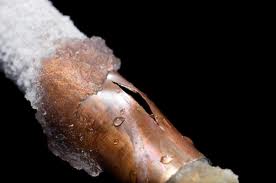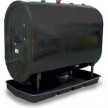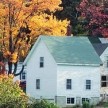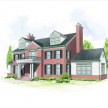Winterizing A Home
Winterizing A Vacation Home
I recently looked at a customers home that was damaged by frozen water pipes, they failed to Winterize their home properly.
This customer turned down his heat super low and went on vacation for two weeks and came back to 5′ of water in his basement. His hardwood floors, kitchen cabinets, furniture and all of the walls 24″ up from the floor were ruined.
Closing a summer vacation home for the Winter or leaving your own home during winter for an extended period, means taking a series of steps to protect your investment. Here’s some tips:
Winterizing A Home: Water System
- Shut off water systems by turning off the pump or closing the valve if on city water. Drain the pressure tank.
- Open all faucets and allow the pipes to drain.
- Flush toilets and drain all water out of the flush tank.
- Add non-toxic antifreeze, to toilet bowls and all drain traps.
- Be sure to drain flexible spray hoses in showers and sinks.
- Drain water softeners so water will drain back from soft water pipes and controls. Brine tank will probably not freeze.
- Drain water heaters.
Heating Systems
Electric heating systems
Requires no maintenance other than shutting off the power to the heating units or setting the t-stat to 50 degrees.
Hot air heating systems:
- Turn off burner emergency switch which is often located at the top of the stairs.
- Drain humidifier which is usually located on the furnace.
- Forced hot water and steam systems: Drain all water in the system unless the liquid contains anti-freeze. It is wise to have this type of system drained by a plumber unless you are well-informed on the procedures necessary.
Winterize your summer home as you do your winter home. To help conserve energy when the home is not occupied, install a low-heat thermostat. By doing this your home could be maintained at abut 40 F. without a freeze-up, rather than at 55 Ft. which is the lowest temperature at which most thermostats can be set.
Washing Machine and Dishwasher
Water left in hoses and internal components can cause damage when it freezes. In freezing temperatures, water in a washing machine inlet valve and the pump will freeze. In order to protect your machine add a half-gallon of non-toxic antifreeze, similar to what folks use in RVs.
Also, shut off water supply to clothes washer and drain the inlet hoses.
For a dishwasher, add about 1/3 gallon of non toxic antifreeze into the bottom of the dishwasher. Start a cycle with the water turned off to the dishwasher. Let it run for 5-10 mins on any cycle to circulate the antifreeze.
Stored Items
- Remove food, cosmetics, or medicine containers that contain liquid that would freeze from shelves.
- Food in paper or plastic containers should be put in large metal containers to protect from mice or other rodents.
- Remove or hide articles in the house that can be sold and converted to cash such as guns, radios, TV sets, tools or other valuables.
Sewage System
- Force as much water as possible out of traps with a plunger.
- Add antifreeze to each trap so you have at least a 50% solution of ethylene – glycol and water. Sometimes fuel oil can be substituted for antifreeze.
- Check for traps in these locations: kitchen sinks, bathroom sinks, bathtub and/or shower drains, toilets, washtubs, floor drains and maybe a sump pump.
Keep Animals Out
- Cover chimneys dampers tightly so that raccoons cannot enter the house, or birds fall down the chimney.
- Stop up any places in the foundation or around the eaves where squirrels, chipmunks, mice or other small animals can enter.
Heating Systems
- If you have a furnace, change the filter in the beginning of the fall season. Don’t worry about how dirty it is or isn’t, simply replace it with a new one.
- Clean each of the registers in the house. This will help to promote efficiency for your heating system.
- Now is the time to open up the area in front of the registers by moving the furniture, curtains, and loose carpeting away from them. This will allow the heated air to circulate more freely. It will also lessen the risk of fire hazards.
- Have your chimney and its flue inspected by a professional chimney cleaner. Have him remove any accumulated creosote.Tips and Pointers to Remember
- Set heat for 50-55 degrees
- Consider installing and using a thermostat that can be remotely monitored.
- [T-Stat Tip: Many of these T-Stats require a 3-wire connection. Check to see if your wire has 3 wires or have an electrixcian run a new wire]









